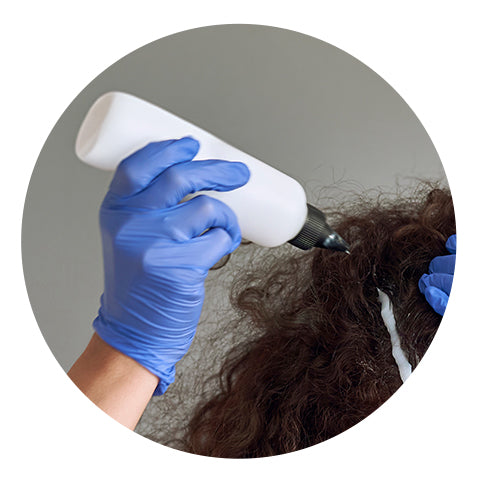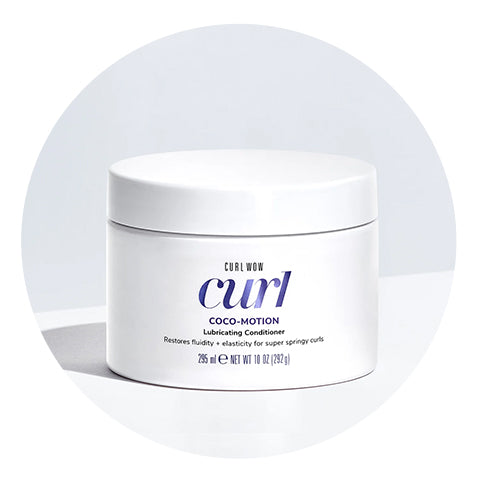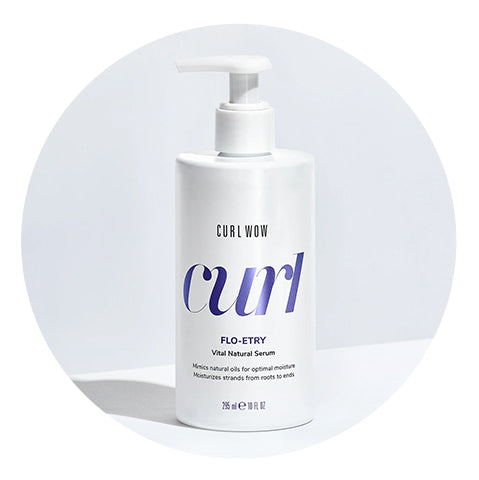Reviving Your Curls: A Step-by-Step Guide on How to Fix Damaged Curly Hair
If your curlies aren’t curling like their usual best selves, chances are you’re dealing with damaged curls. Unfortunately, due to the natural dryness of curly hair, this hair type is especially delicate and easily prone to damage.
Whether it’s loss of curl pattern, extreme frizz or heat damage that has you on edge, the good news is not all hope is lost. We're here to help!
In this guide, we'll explore the key causes of damaged curls and provide you with tips on how to fix and prevent further damage, with a little help from Color Wow Chief Chemist, Dr. Joe Cincotta.
What does damaged curly hair look like?
If the epitome of healthy-looking curls is bouncy, shiny and defined, then damaged curly hair is quite literally the opposite. We’ll let Dr. Joe explain:

“Healthy, virgin hair has two key structural components: the cuticle and cortex. Hair damage occurs when either (or both!) of these structural components of your hair strands are compromised by physical and/or chemical aggressors.”

“This causes the hair to look and feel unhealthy,” Dr. Joe continues. “Because of the unique shape of curly/coily hair, with its twists and turns, it is more susceptible to both surface (cuticle) damage and internal (cortex) damage.
Cuticle damage leads to rough, dull, tangled hair that often splits at the ends and has a frizzy surface. Damage to the cortex, typically by chemical processes and excessive heat, leads to loss of strength and elasticity and results in hair breakage.”
Signs of damage aren’t always immediately noticeable. Rather, it can be a sneaky process. One where, overtime, you’ll find you have more bad hair days than good ones. Here are some of the most common signs to look out for:
- Frizz: While some frizz is natural for curly hair, excessive frizz may indicate damage. Frizz is caused when your cuticle layer is raised. This in turn makes it more difficult for your strands to retain critical moisture, causing hair to look frayed and feel rough. Our guide to frizzy curly hair goes into more detail on this!
- Dryness: Because damaged curly hair often has a raised cuticle, it’s much harder to retain critical moisture, making hair appear dry and brittle. It also doesn’t help that the scalp’s natural oils (sebum) have a hard time traveling down the twists and turns of curly hair to moisturize. You can find out more about why curly hair gets so dry in our article.
- Tangles and Knots: Curly hair is prone to tangling, but when damaged, the tangles can become more frequent and harder to remove, often leading to knots that are difficult to manage. This is because when the cuticles are raised, they snag on each other, creating tangles.
- Lack of Elasticity: Healthy curly hair stretches when wet and returns to its original length without breaking. Damaged curls lose this elasticity, which destroys their natural bounce-back and healthy-looking springy, bundled appearance. Loss of elasticity leads to breakage when curls are wet or stretched out.
- Split Ends: The ends of the hair may split into two or more fragments, which is a clear sign of damage often caused by mechanical stress or environmental factors. Be sure to check out our blog on how to handle split ends for more information.
- Dullness: A loss of shine and luster can indicate that the hair is damaged. Healthy curls reflect light better, giving them a shiny appearance.
- Uneven Curl Pattern: When curly hair is damaged, the natural curl pattern can become inconsistent, with some strands losing their shape and others remaining curly.
- Texture Changes: The hair may feel coarse or straw-like due to the raised cuticles and loss of moisture content.
- Breakage: Hair that snaps off easily when combed or styled is likely damaged. This can result in shorter, flyaway strands or a canopy of frizz.
- Difficulty in Styling: Damaged curly hair may not respond well to styling and may not hold styles as effectively as healthy hair.
What are the key causes of damaged curls?
Before we dive into the solutions, let's take a closer look at some of the main culprits behind damaged curly hair:
1. Heat styling
 Hot tools and blow dryers can all wreak havoc on your curls. The excessive heat strips your hair of moisture, leaving it dry, brittle, and prone to breakage. It's important to use heat styling tools sparingly and always protect your hair with a heat protectant.
Hot tools and blow dryers can all wreak havoc on your curls. The excessive heat strips your hair of moisture, leaving it dry, brittle, and prone to breakage. It's important to use heat styling tools sparingly and always protect your hair with a heat protectant.
That’s why, at Color Wow, we formulated every leave-in treatment and styler with heat protection, so you’re always protected!
When it comes to heat styling, it's not just the tools themselves that can cause damage. The temperature at which you use these tools also plays a crucial role. High heat settings can be particularly damaging to curly hair, so it's important to find a balance that allows you to achieve your desired style without compromising the health of your curls. Visit our guide to protecting hair from heat damage for more information.
2. Chemical + Color Treatments
 Chemical treatments, such as relaxers, and color treatments, can take a toll on your curls. These processes can weaken the hair shaft and cause damage and breakage.
Chemical treatments, such as relaxers, and color treatments, can take a toll on your curls. These processes can weaken the hair shaft and cause damage and breakage.
If you're considering a chemical treatment, be sure to consult with a professional stylist who specializes in curly hair to minimize the risk of damage.
Additionally, it's important to give your hair time to recover between these kinds of salon appointments. Overprocessing your hair can lead to severe damage and even hair loss. If you're unsure about whether your hair is ready for another treatment, it's best to err on the side of caution and wait until your curls are in a healthier state.
3. Mechanical stress
 The third key cause of curly hair damage is mechanical stress, which encompasses a range of physical actions from brushing and combing to the way we handle our hair during styling and even while sleeping.
The third key cause of curly hair damage is mechanical stress, which encompasses a range of physical actions from brushing and combing to the way we handle our hair during styling and even while sleeping.
Curly hair is inherently delicate, and rough handling can cause the curls to snap and break.
Vigorous towel drying can rough up the cuticle, leading to frizz and tangling, while tight hairstyles can put undue stress on the hair follicles, potentially leading to traction alopecia. Even the friction from cotton pillowcases can cause abrasion and breakage over time.
To mitigate these issues, it's advisable to detangle gently with a wide-tooth comb or fingers, preferably when the hair is coated with a product that provides slip.
(Our go-to? Snag-Free Pre-Shampoo Detangler, the first step in our Curl Wow regime.)
Opting for protective hairstyles that minimize tension, using microfiber towels or t-shirts to blot dry, and switching to silk or satin pillowcases can all help maintain the health of curly hair, ensuring that each strand can flex and move without the risk of damage.
Chemical treatments, heat styling, and rough handling are major reasons why curly hair gets damaged, but they're not the only ones. There are other things that can hurt your curls too.
For example, spending too much time in the sun can dry out your hair, and really cold or windy weather can do the same. If the water in your shower is really hard, it can leave stuff minerals or other residues on your hair behind that make your hair brittle (check out our guide to hard water’s effects on hair for more information).
And don't forget, if you're not eating right or you're super stressed, your hair can show it by looking dull and being more likely to break. These things might not be as obvious as a bad dye job or the sizzle of a flat iron, but they can still do a number on your hair over time. It's good to keep these in mind if you want to keep your curls looking their best.
How to repair damaged curly hair: our top tips
Now that you know some of the common causes of damaged curls, let's explore how you can restore your hair's health and vitality.
1. Assess the damage
Before you can begin fixing your damaged curls, it's important to assess the extent of the damage. Take a close look at your hair and identify any areas that are particularly dry, brittle, or prone to breakage. This will help you determine which treatments and products will be most effective for your specific needs.
When assessing your hair, pay attention to the texture, elasticity, and overall condition. Look for signs of split ends, frizz, and lack of shine. By understanding the current state of your curls, you can tailor your hair care routine accordingly.
2. Deep condition regularly
 One of the best ways to nourish damaged curls is by incorporating deep conditioning treatments into your routine. Look for products that are specifically formulated for curly hair, like our Coco-Motion Lubricating Conditioner. Formulated with our proprietary Profaxil-18™ Complex, it breaks down the oil particles (from marula and coconut oils) so they’re better able to penetrate the hair shaft, providing deep hydration and restoring moisture to your curls.
One of the best ways to nourish damaged curls is by incorporating deep conditioning treatments into your routine. Look for products that are specifically formulated for curly hair, like our Coco-Motion Lubricating Conditioner. Formulated with our proprietary Profaxil-18™ Complex, it breaks down the oil particles (from marula and coconut oils) so they’re better able to penetrate the hair shaft, providing deep hydration and restoring moisture to your curls.
When applying a deep conditioner, make sure your hair is clean and damp. This allows the product to penetrate the hair more effectively. Gently massage the conditioner into your curls, focusing on the ends and any areas that are particularly dry or damaged. Leave the conditioner on for the recommended amount of time, allowing it to work its magic. Rinse thoroughly to remove any residue.
Deep conditioning should be done regularly to maintain the health and vitality of your curls. Aim for at least once a week, or more frequently if your hair is severely damaged.
3. Trim regularly
Regular trims are essential for maintaining healthy curls. Trimming off split ends and dead ends will prevent further damage and promote healthy hair growth. Be sure to schedule regular appointments with a hairstylist who understands the needs of curly hair.
4. Avoid heat styling
While it may be tempting to reach for your hot tools, avoiding heat styling is crucial for repairing damaged curls. The excessive heat can further dehydrate your hair and exacerbate the damage. Instead, embrace your natural curls and opt for heat-free styling.
Air drying is the gentlest way to dry your curls. After washing your hair, gently squeeze out any excess water using a microfiber towel or an old t-shirt. Avoid rubbing your hair vigorously with a regular towel, as this can cause frizz and breakage. Then, apply your favorite air-dry styler. Here are a few of ours:
Dream Coat for Curly Hair
Ideal for 2a to 3b waves and curls, this one-step styler delivers all the benefits of creams, gels and serums without weight, grease, frizz or crunch.
 Flo-etry Vital Natural Serum
Flo-etry Vital Natural Serum This lightweight serum replaces the essential scalp oils (sebum) that curls lack because oils can’t flow down the natural bends + twists for glossy, juicy results. Clinically proven to deliver 84% less breakage.
 Shook Mix + Fix Bundling Spray
Shook Mix + Fix Bundling SprayMix-to-activate spray combines a “layer” of advanced styling polymers with a “layer” of powerful moisturizing oils for perfectly defined, weightless, glossy, frizz-free curls. Clinically proven to deliver 78% less frizz in high humidity.
Allow your curls to air dry naturally, and avoid touching them too much during the drying process to prevent disrupting the curl pattern. Worried about fly-aways? Check out our article on how to stop frizz in its track when air drying.
If you prefer to speed up the drying process, you can use a diffuser attachment on your blow dryer. This helps to distribute the heat evenly and minimizes frizz. Set your blow dryer to a low or medium heat setting and gently cup your curls with the diffuser, lifting them at the roots for added volume.
By addressing the causes of damage, taking preventative measures, and using nourishing treatments, you'll be well on your way to healthier, bouncier curls that make heads turn.
–
Read more about caring for curly hair on the Color Wow Blog:

















